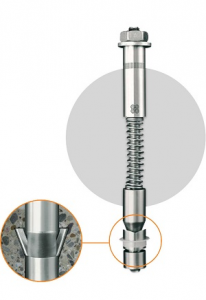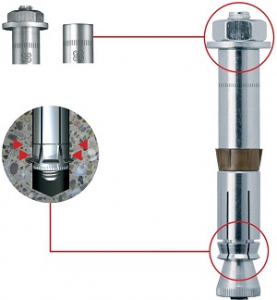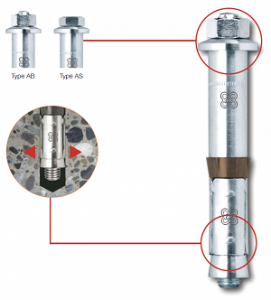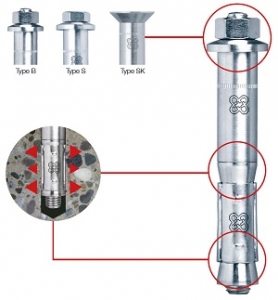LIEBIG
Suppliers of: Undercut Anchor Bolts, Anchor Bolt, Safety Bolts
When the EJOT fastener manufacturing Group acquired the LIEBIG brand in 2017, it made a commitment to provide full accessibility to the LIEBIG product range and the technical data that supports it.
The unique modular design and absolute strength of LIEBIG anchoring products is well known by structural engineering professionals around the world. The LIEBIG brand has an unrivalled reputation to deliver outstanding strength and performance in its unique portfolio of anchoring products. Now this proven technology is part of EJOT’s own manufacturing excellence and specification support facility around the world, making LIEBIG products and the technical guidance to support them openly accessible.
For structural engineers, being less familiar with the EJOT brand is understandable, unless career paths have included sorties into the numerous sectors that comprise industrial roofing, cladding and insulation. Designing and manufacturing fastening solutions for this domain is EJOT’s world.
LIEBIG anchoring technology and EJOT’s manufacturing and technical support is now one market force. LIEBIG products are hallmarked classics and the modular nature of the range makes all LIEBIG anchors easy to adapt and easy to create bespoke lengths and assemblies quickly, efficiently and cost-effectively. All LIEBIG anchors have Option 1 and Option 7 ETA approvals for cracked and non-cracked concrete.
For use where safety is paramount, typical applications include installations into nuclear power plants, cranes, industrial plants, conveyor systems and also for special civil engineering solutions.
Together EJOT and LIEBIG are making this unique anchoring technology and the technical knowledge to support specification readily accessible; putting the LIEBIG product range firmly back in the hands of the engineer.
Our Product Range Includes:
Ultraplus M12 - M36:
The LIEBIG ULTRAPLUS® anchor offers the highest tensile and shear performance of any other undercut anchor, from 320KN tensile load and beyond!
-
LIEBIG® Ultraplus - Anchoring of Steel Structures and Baseplates in Nuclear Power, Oil, Gas and Water Treatment. The Ultraplus ZP can be installed in the most Heavy Structural Applications.
-
LIEBIG® Ultraplus A4 - The undercut anchor for exceptionally high loads in cracked and non-cracked concrete – also for shock and seismic loads.
SAFETY BOLT M6 - M20:
The LIEBIG Safetybolt design with its double expansion gives optimal frictional resistance for a strong and controlled installation giving you a more secure performance for steel construction, ligfting systems and more. With it’s high load capacity the LIEBIG Seafetybolt is second to none.
- LIEBIG® Safety Bolt B - Double expansion, heavy duty anchor for increased security
-
LIEBIG® Safety Bolt B A4 - A solid steel safety bolt available with a hex nut, domed washer and threaded stud or a hex head screw with domed washer or even with a countersunk headed screw for a flush finish this high capacity anchor can be used in both cracked and non-cracked concrete.
-
LIEBIG® Safety Bolt S A4 - With its uniformed expansion of the sleeve over the entire length, Solid all-steel construction and torque indication from domed washer the Liebig safety bolts performance is second to non. With custom lengths available on request you can be assured that we have the best solution for your project.
-
LIEBIG® Safety Bolt SK - Application of the installation torque causes the anchor’s two opposing cones to be drawn into the expansion sleeve. This causes the sleeve to be pressed against the sidewalls of the hole over its entire length and results in optimum frictional resistance and high load capacity in cracked and non-cracked concrete.
-
LIEBIG® Safety Bolt SK A4 - With cylindrical expansion for optimal friction resistance, higher anchoring intensity from twin-cone design and torque indication from domed washer the Liebig safety bolt gives you peace of mind.
-
LIEBIG® Safety Bolt S - A twin-cone sleeve anchor for high loads, Torque-controlled mechanical anchor manufactured in a Solid, all-steel construction suitable for use in both cracked and non-cracked concrete.
LIEBIG ANCHORBOLT M6 - M16:
The LIEBIG Anchor Bolt is a general purpose, heavy duty anchor for use with high loads and high economic capacity. The unique design gives torque indication for a presice and controlled installation.
-
LIEBIG® Anchor AB A4 - Used for fFixing down of steel baseplates, columns and structural steel beams in both cracked and non-cracked concrete this Liebig anchor gives you the performance you need.
-
LIEBIG® Anchor AS - General purpose heavy duty anchor. This is an economical anchor for wide range of uses complete with torque indication from its domed washer.
-
LIEBIG® Anchor AS A4 - An economical high capacity anchor approved for use in cracked and non-cracked concrete. Some of the applications this great anchor can be used in include Steel construction, Cable trays, Railing, Machines, Gates, Façades, Lifting systems and Base plates to name but a few.
-
LIEBIG® Anchor AB - A carbon steel zinc plated anchor, ETA approved for cracked and non cracked concrete complete with hex nut. Available in thread size M6 to M16 and as well as standard lengths special lengths are also available.
SUPERPLUS M8 - M16:
The LIEBIG SUPERPLUS® anchor is an undercut anchoring system that does not require any special setting tools. An undercut anchor with the ease of installation of an expansion anchor you only need apply torque to create the self-undercut.
-
LIEBIG® Superplus BLS - The undercut fixing system that does not require a special setting tool.
-
LIEBIG® Superplus BLS A4 - Automatic self-undercutting. The unique design of the SUPERPLUS causes an undercut to be created when the installation torque is applied. The sleeve’s outer cutting teeth expand and undercut into the base material.
-
LIEBIG® Superplus BLS P - High capacity anchor for cracked and non-cracked concrete the Liebig Superplus has Increased reliability due to undercut technology.
-
LIEBIG® Superplus ILS - A high capacity anchor for cracked and non-cracked concrete with increased reliability due to undercut technology. Simple installation, no special drill bit or setting tool required while applying torque creates undercut thus allowing reduced edge distances and spacings. With two approved embedment depths per diameter the Superplus boasts a lower installed cost than traditional undercut anchors. Approved for fire resistance.
-
LIEBIG® Superplus SLS:
-
LIEBIG® SUPERPLUS SKLS:
For more information or technical downloads please visit our websites:
- www.liebig-ultraplus.co.uk - The undercut anchor for exceptionally high loads in cracked and uncracked concrete
- www.liebig-anchor.co.uk - High Capacity General Purpose Anchor
- www.liebig-safetybolt.co.uk - Twin-cone heavy duty anchor for high-power performance
- www.liebig-superplus.co.uk - The undercut fixing system that does not require a special setting tool.
Social Media:
or visit our literature section here on BPI.
High performance critical fastening with first class, full technical support.
Anchoring expertise provides bespoke solution for seismic marine application
 EJOT UK has delivered an innovative LIEBIG concrete anchoring solution for a key part of critical safety infrastructure used in the maintenance of Royal Navy submarines at Devonport Royal Dockyard.
EJOT UK has delivered an innovative LIEBIG concrete anchoring solution for a key part of critical safety infrastructure used in the maintenance of Royal Navy submarines at Devonport Royal Dockyard.
The Project
The project at Babcock International’s facility within HMNB Devonport – the largest naval base in Western Europe – involved the replacement of corroded anchors that were securing a large cast iron brow hanger to the dock side. These hangers enable the secure attachment of the naval brow – a linking structure between the dock wall and the vessel – which accommodates the high-pressure hoses and pipes used to test the propulsion systems of vessels in dock.
The dock is part of the extensive infrastructure at Devonport which has been supporting the Royal Navy since 1691. Spread over more than 650 acres, the dockyard has 15 dry docks, four miles of waterfront, 25 tidal berths and five basins. Its vast scale makes it a major part of Plymouth’s economy, employing 5500 people, directly supporting 400 local firms and representing 10% of the city’s income.
The brow hanger requiring refurbishment is located in a dry dock used for the maintenance and refit of HM Navy’s submarine fleet, including its nuclear-powered Trafalgar and Vanguard-Class submarines. All eight of the hanger’s existing anchors, which were installed to an embedment depth of up to 550mm, had become corroded through long term exposure to the atmospheric conditions, but the process of replacing them had to navigate a number of complexities.
Most significantly, it was vital for the anchors to be extracted without damaging the rebar within the dock wall. Any interference with the existing rebar would affect the structural and seismic integrity of the dock side and in doing so lead to extensive and potentially costly remedial work. This could, in turn, disrupt the vital work undertaken 24/7 to keep the UK’s naval submarines operational.
But this was only part of the challenge. It was also crucial that the proposed solution could be fully assessed in a reliable test environment to give Babcock International’s team complete confidence in its integrity throughout its service life.
With its extensive anchor design and manufacturing expertise, EJOT UK was ideally placed to help with a bespoke LIEBIG solution as Paul Papworth, its structural anchoring specialist explains.
“We provided engineering consultancy over a period of weeks, including four site visits,” says Paul. “In order to arrive at the most effective anchoring solution, our engineers undertook a series of remote calculations before preparing installation methodology and providing assessments on the suitability of varying alternatives.
“By partnering with one of the industry’s leading diamond cutting and coring specialists, Core Cut Ltd, we were able to conduct off site trials in order to evaluate and prove the effectiveness of the different alternative solutions.
“These trials were an invaluable part of the investigation and solution preparation. They allowed us to replicate the proposed process, evaluate its accuracy and forecast the time involved for the removal and replacement of the anchors. By utilising the expertise of Core Cut Ltd, we could ensure the removal of the corroded anchors could be completed with total precision and with no damage to the dock’s existing rebar.
“We were able to confirm this using a microscopic camera (a borescope) inserted into each of the holes, which provided the basis for a report on the condition of the substrate and condition of the existing rebar after drilling.
“The final proposals and results from trials was presented for comprehensive review by a three-tier approval chain culminating with the dock board who ultimately accepted our solution.”
Tests also sought to provide evidenced basis for the type of anchor replacement critical to the testing of nuclear submarines after major re-fits. The seismic standard to which this dockyard was originally constructed during the Cold War had to be maintained, so any anchoring approach needed to be able to demonstrate structural performance to this level.
The Solution
The solution provided by EJOT UK utilised the EJOT SE800 epoxy resin in combination with specially made resin studs. These 8 x M36 large diameter HCR (high corrosion steel) studs were manufactured in 1.4529 steel in order to meet life expectancy in this harsh environment as well as the load capacity of the application. They were selected based on the need to reduce the possibility of contacting or cutting the rebar during insertion which surrounded the existing installed anchors.
EJOT SE800 is a two-component injection resin based on pure epoxy resin for high performance and structural applications. Designed for anchoring threaded studs into cracked and non-cracked concrete, it was the ideal solution for the Devonport project because it is suitable for use in wet and flooded areas.
Paul adds, “The solution we developed for Devonport dockyard demonstrates our flexibility to be able to go way beyond standard products, meet the complex requirements of the application and partner with experts in other technology fields to provide totally bespoke solutions. We can do this because of the wealth of anchoring technology and construction expertise we have within the EJOT Group, particularly within our LIEBIG business. This ensures we can offer our customers a more innovative approach to overcome specific challenges.”
Option 1 & Option 7 LIEBIG Anchor Technology
 Option one and option seven are two types of ETA-approved undercut anchors, a special kind of anchor installed into concrete and brick that is proven to be one of the strongest on the market for supporting structures such as steel columns and tunnels. For this reason, engineers often use these anchors for high-load projects in power plants, nuclear facilities and theme parks, where the consequences of structural failure could be catastrophic.
Option one and option seven are two types of ETA-approved undercut anchors, a special kind of anchor installed into concrete and brick that is proven to be one of the strongest on the market for supporting structures such as steel columns and tunnels. For this reason, engineers often use these anchors for high-load projects in power plants, nuclear facilities and theme parks, where the consequences of structural failure could be catastrophic.
To install an anchor bolt, a hole of specific depth and diameter must first be drilled into the concrete member. After clearing the hole of dust and debris, an undercut is created using a special drill that can bore a notched opening to accommodate the bolt’s expanding segments, which can then be driven into the hole and expanded to form the undercut connection. Also known as the positive mechanical interlock, this mechanism relies on the compressive strength of the member to balance the application’s static and dynamic loads.
Option-One: For Cracked and Non-Cracked Concrete
ETA Option 1 undercut anchors are approved for cracked and non-cracked concrete, including in floors, ceilings and walls. This is the strongest type of undercut anchor available out of the twelve options that have been granted a European Technical Assessment (ETA) marking, which is a technical standard used to detail and verify the performance of construction products.
As option 1 can be used for cracked and non-cracked concrete, this means that it is able to safely support applications in areas most vulnerable to cracking, otherwise known as the tension zone. As the name suggests, this is where a concrete member experiences the most stress under load and, as a result, will be the most likely location for cracking to appear. While cracking is a sign of fatigue, the reliability of this setup means that the steel anchor will likely fail before the concrete, allowing engineers to better anticipate outcomes because steel failure is more predictable than concrete failure.
Option Seven: A Versatile Undercut Anchor
Option 7 is part of a class of undercut anchors (options 7-12) that is ETA-approved for non-cracked concrete applications. While not suitable for tension zones on concrete members, this option is very versatile for concretes with a strength class over 20/25. Anchors are often required in many different locations on a concrete member, and sometimes in close quarters with other anchors.
For this reason, option 7 undercut anchors are very useful. They have been tested under load and approved for areas where space is limited and the edge distances are small, making them ideal for bolting awkward attachments.
LIEBIG-Anchor-AS
Advantages of Using Undercut Anchors
– The positive mechanical interlock mechanism ensures that fixtures remain secure, even under dynamic loads.
– Undercut anchors are made from highly durable, strong materials that go beyond the minimum safety requirements.
– This reliability is matched by the range of options available for cracked and non-cracked concrete scenarios.
– They are ideal for tight spots where the anchor spacing and edge proximity is tight.
European Technical Assessment
As previously mentioned, the European Technical Assessment is the standard-bearer for ensuring that an anchor is safe to use for certain applications and materials and, therefore, this should be considered when sourcing undercut anchors.






